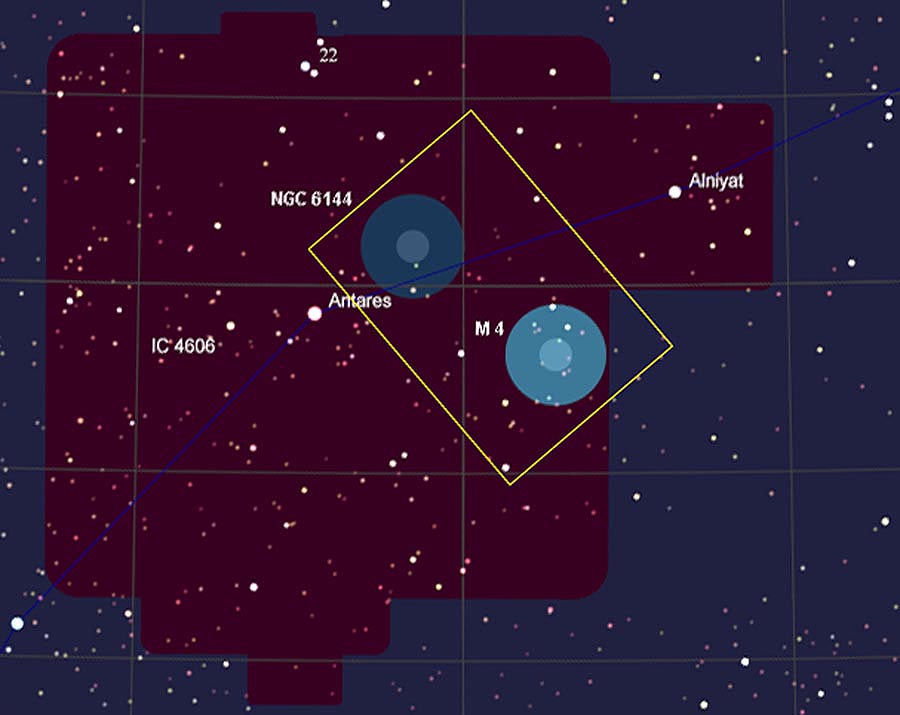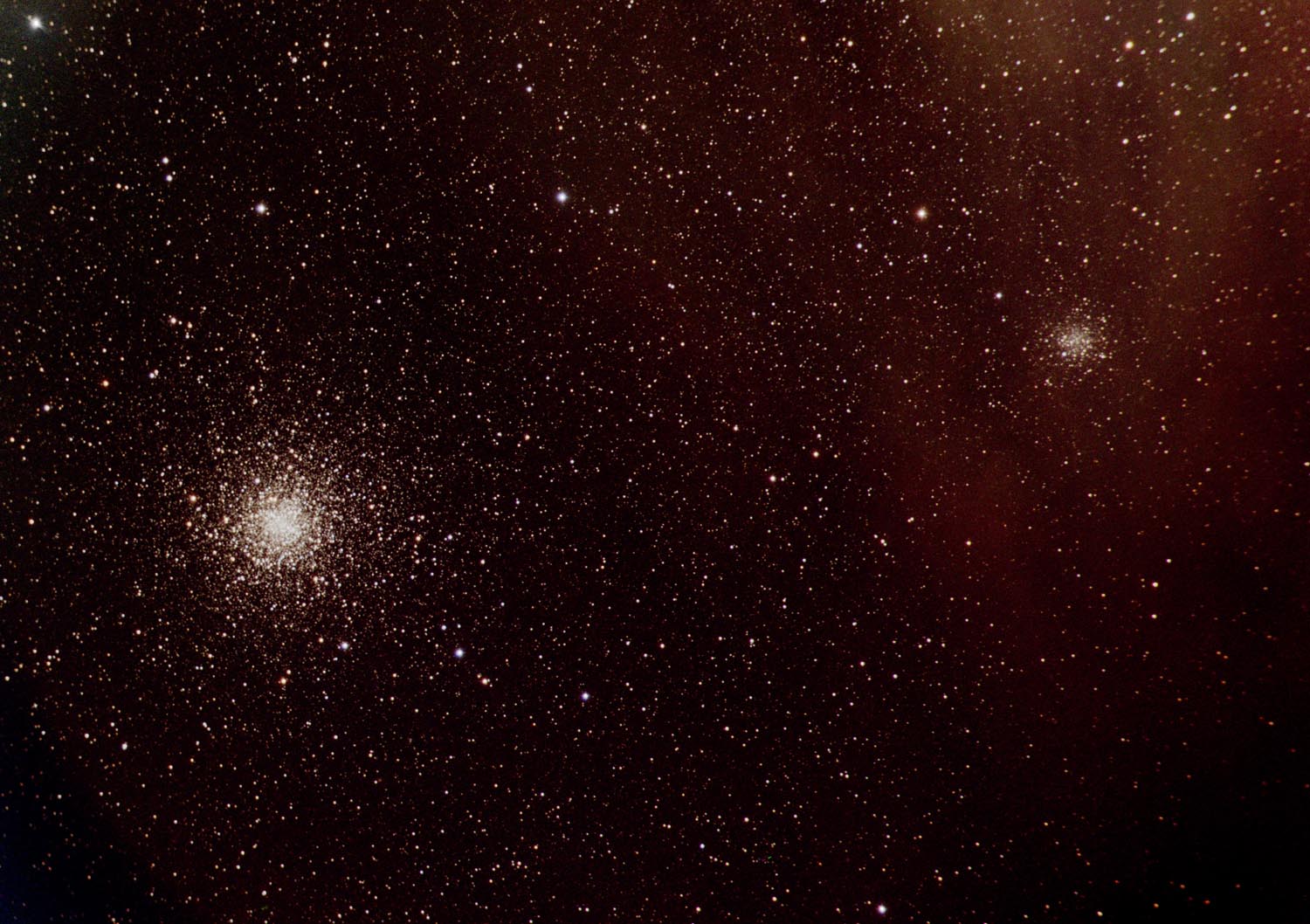
 | SOCO Blog |
23 June 2015
M 4 AND NGC 6144
The skies are finally clearing after a long rainy period under the "Summer Monsoon" so I can get back to doing some imaging. Of course, the dominant summer constellation is Scorpius, which is rising high in the southern sky these nights. In addition to being "my sign", Scorpius has always been my favorite constellation. This is in part because, when the first stars of its head were visible rising above the horizon after sundown, it meant that school would soon be over and summer vacation would be starting. So, even in modern times, school kids in Central Texas can use the stars to foretell important occurrences.
Scorpius contains many interesting deep-sky objects, some of which make fine targets for binocular viewing. One that I've enjoyed observing over the years in M 4 (NGC 6121), the beautiful globular cluster adjacent to fiery Antares. One of the great things about this object is that it's so easy to find. If you aim the binoculars between Antares and the next bright star to the east (Alniyat), the cluster should be in the field of view. With a visual magnitude of 5.9, M4 is a softly glowing ball of light through binoculars. Through the telescope, it's easily resolvable into a myriad of tiny stars.
It wasn't long ago that I realized that M 4 is not the only globular cluster in that immediate region. There is a less-conspicuous globular, NGC 6144, located even closer to Antares. As shown in the star chart in Figure 1, the two clusters are separated by one degree. With a visual magnitude of 9.1, NGC 6144 is much dimmer than M 4. With an apparent diameter of 9.3 arc-min, NGC 6144 is also much smaller than M 4, which has an apparent diameter of 26.3 arc-min. I have not been successful in spotting NGC 6144 with my 10 X 50 binoculars.

Figure 1. Star chart showing the location of the two globular clusters relative to Antares. Imaged region is indicated by the yellow box.
Source: Cartes du Ciel.
My recently acquired image of the two clusters is shown below. Both fit nicely within the image frame using my QSI Model 583 camera with an Optec NextGEN Ultra Widefield 0.7X Telecompressor. As you would expect, M 4 is a grand object in the image. It contains at least 100,000 stars, with more than 10,000 of them brighter than magnitude 19. The stars in M 4 are not as densely packed as in some other prominent globular clusters, like M 13 in Hercules. It's actual diameter is only around 57 LY, so its apparent visual size is due to its closeness. At 5640 LY, M 4 is the closest globular cluster to us. M4 has an age of around 12,700 MY and contains numerous white dwarf stars. It even contains a millisecond pulsar near its center.

M4 (left) and NGC 6144 (right)
As indicated in the image, NGC 6144 is a less-than-spectacular object. It's relatively small and sparse, and some have said that it looks like it was made from the left-overs from M 4. NGC 6144 is much farther away than M 4, at a distance of around 29,000 LY. This distance contributes to its dimmer appearance since, located near the galactic plane, its light experiences considerable attenuation and reddening by the intervening amounts of interstellar dust near the galactic center. Upon processing and contrast-stretching this image, I was surprised to see the reddish traces of nebula so easily visible along the upper right side of the image. As shown in Figure 1, this feature is part of a large nebular structure (indicated in the chart by the reddish color) centered on Antares that bears the collective identifier IC 4606. The common name for this feature is the "Antares Nebula." It is a vast region of dust and gas illuminated by Antares itself (which would be just outside the upper right corner of the image). The presence of this nebula increases the background brightness, which contributes to the difficulty in resolving NGC 6144. The whole region around Scorpius is laced with bright and dark nebulas, which makes this region particularly interesting to atro-imagers.
The image of these two clusters was created from ten 90-second exposures in each of the red, green and blue spectral bands. This image has the distinction of being the first created using SIAM, the "SOCO Image Autoprocessing Module". This is a large computer program that I have written to automatically perform many of the image processing functions necessary to produce a final color composite image. In the past, it would take me 3-4 hours to process all the images acquired for a target. With SIAM, most of the processing can be done in a few minutes. Its use has a number of important benefits. Since all the tedious, time-consuming processing tasks are handled by the software, I can acquire more images of a target without increasing the amount of work that I have to do processing the images. In addition, I have a large archive of images that I acquired over the past few years before I developed the image processing techniques described on this website. With SIAM, I can easily go back and re-process the original image files to produce new composite color images of these targets.
With the help of SIAM, I should be able to get imagery onto this website at a faster pace. Whether you're building cars or imaging stars, automation makes the task a lot easier!
 Return to SOCO Blog Page
Return to SOCO Blog Page
 Return to SOCO Main Page
Return to SOCO Main Page
Questions or comments? Email SOCO@cat-star.org